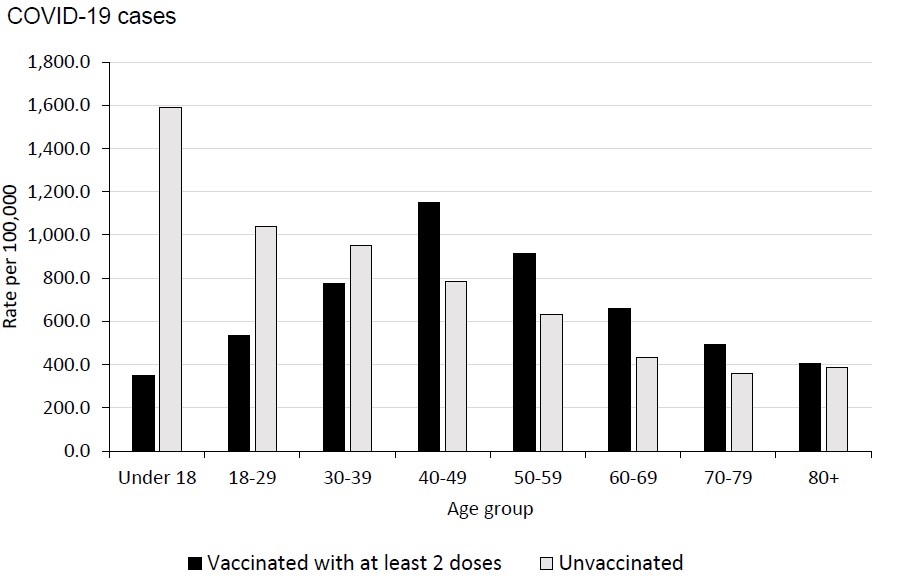It’s official: I am spouting misinformation about the Covid vaccines. Full Fact – the Google, Facebook and George Soros-funded outfit that Ofcom has said it relies on to tell it what to censor regarding COVID-19 – has ‘fact checked‘ my recent piece on PHE data showing negative vaccine effectiveness in August and branded it “incorrect”.
Writer Leo Benedictus – henceforth to be known as the Oracle – takes particular issue with the headline, which he says “falsely claims that a report from Public Health England (PHE) shows the COVID-19 vaccines having ‘negative effectiveness’ in the over-40s”.
“This is not true about the COVID-19 vaccines – nor is it true that the PHE report shows this,” the Oracle declares. Except it is. The data contained in the report is completely clear, and the calculation of unadjusted vaccine effectiveness from that data is straightforward.
According to the Oracle, however, this is not a valid way of estimating vaccine effectiveness. Benedictus quotes the PHE report stating as much – “The vaccination status of cases, inpatients and deaths is not the most appropriate method to assess vaccine effectiveness and there is a high risk of misinterpretation” – and notes that I too quote this. What he fails to acknowledge, though, is that I also examine the reason PHE gives for this claim and counter it.
The only substantive reason PHE gives that vaccine effectiveness might be underestimated in its data is that “vaccination has been prioritised in individuals who are more susceptible or more at risk of severe disease”. In other words, the high-risk are over-represented in the vaccinated and this skews the sample. I countered that the large majority of the older age groups are now vaccinated so this bias should be very much reduced. Of course, we also need to ask why, if this is supposedly the key confounder of the data presented, we are not also provided with the necessary data on risk categories so that it can be duly quantified and accounted for.
Benedictus reiterates PHE’s claim that vaccine effectiveness should only be estimated via the published studies. However, as I noted in my article, these studies are riddled with serious problems and inconsistencies that bring their findings into question. They are also out of date since they don’t cover the Delta surge, which is the first time the vaccines have really been stress-tested in the U.K.
Benedictus spends half the ‘fact check’ in a bizarre attempt to argue that my vaccine effectiveness calculation is wrong because I used the data PHE itself used for the size of the unvaccinated population. He points out it is different to the ONS figures on this. Er, take that one up with PHE, Leo.
It does seem at times that Benedictus is fact-checking the PHE report rather than my article. At one point he takes the report to task because one of its charts sowed confusion as it “seemed to show for the month in question (August 9th to September 5th) that people in their 40s, 50s, 60s and 70s were more likely to test positive for Covid if they had been vaccinated than if they hadn’t”.
Except the chart didn’t ‘seem’ to show that; it did show that. Again though we are told that this data does “not give a reliable estimate of vaccine effectiveness” because of biases in the samples.
But who defines what makes an estimate of vaccine effectiveness ‘reliable’ enough to be permitted without being labelled false? All vaccine efficacy estimates have limitations arising from the limitations of the data, including those produced by PHE. I was careful to acknowledge the limitations of the estimates I was making, saying they were unadjusted for risk factors – though argued that this shouldn’t matter so much anymore given high coverage. There’s also the point that being high-risk may affect the risk of serious disease and death but there’s no reason to think it will have an impact on infection rates (save for the small number of immuno-compromised).
The unmistakable impression here is of a gatekeeping exercise by the Government and its outriders to ensure it controls the concept of vaccine effectiveness and no one unauthorised is allowed to make an estimate of it. Thus the availability of the data is carefully controlled and we only get a month at a time and without the additional data that would allow us to control for the supposed biases that the report tells us the data includes and which ‘invalidate’ any attempt to make an unauthorised calculation of vaccine effectiveness.
None of this concept-policing does anything to alter the facts, however. In recent weeks reported infection rates have been higher in the double vaccinated than in the unvaccinated for the over-40s. That means that, for this period, (unadjusted) vaccine effectiveness is negative in those age groups.
PHE has published two new reports since my article and in each the unadjusted vaccine efficacy has declined further. Here is the table using data from the latest report, covering August 23rd to September 19th (the related chart from the report itself is above).

It shows that in the two weeks since my article the vaccine effectiveness has dropped further, with unadjusted vaccine effectiveness in the over-40s now hitting as low as minus-53% among people in their 60s. This means that, on this data for this age group, the double vaccinated experienced a 53% higher reported infection rate than the unvaccinated in the past month. And that’s a fact.
Stop Press: Professor Norman Fenton and Professor Martin Neil on the Probability and Risk site have used age-adjusted all-cause mortality to estimate vaccine effectiveness and found that mortality rates are currently higher in the vaccinated than the unvaccinated.
Stop Press 2: Professor David Paton has produced a good Twitter thread responding to one of the more well-informed critics of this (and other) pieces citing the PHE data.

